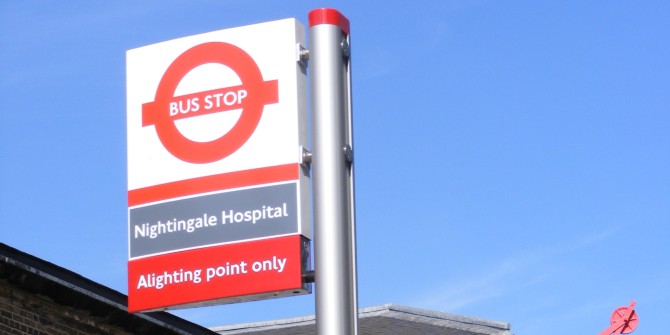In less than a month, the NHS created 33,000 extra beds to accommodate COVID-19 patients. Now they lie unused. Rocco Friebel (LSE) says the Nightingale hospitals could help clear the backlog of patients waiting for procedures that were delayed by the pandemic – and address the pre-existing shortage of beds.
Anticipating an influx of COVID-19 patients requiring emergency treatment, NHS leadership managed to achieve the inconceivable. In less than one month, more than 33,000 hospital beds were created – approximately one third of the existing general and acute bed stock, and equivalent to 46 average-sized hospitals in England.

This arduous task was achieved through the construction and opening of seven Nightingale hospitals, promoting early discharges of patients, and postponing elective care – making pre-pandemic government efforts to invest in NHS capacity seem pitiful.
The recent policy directive reverses decades of effort to reduce hospital bed capacity in the NHS. In the past 30 years the number of hospital beds has been halved, to 2.5 beds per 1,000 population. This has left the UK with one of the lowest bed-to-population ratios across OECD countries. Cutting bed numbers followed a conscious drive to improve efficiency by reducing the number of hospital admissions, or giving hospitals incentives to shorten the length of stays. While some of these strategies have proven successful, reductions in hospital bed stock still outstripped demand for hospital services and led to a steady rise in average bed occupancy rates to above 92%, with many hospitals intermittently working at maximum capacity.
Given these numbers, it becomes clear why so many were fearful about the NHS’s ability to deal with an additional influx of COVID-19 patients.
The consequences of high bed occupancy are detrimental to patient care. In a recent paper published in Health Policy, we examined the impact that high bed occupancy has on Accident & Emergency (A&E) performance. The NHS as a whole has not met its 4-hour waiting target since 2013, with one in six patients attending A&E waiting longer than 4 hours for a medical decision. We find that high bed occupancy has significant negative spillover effects on the care provided in A&E departments. It is likely a reason why one in ten patients admitted to hospital wait over 4 hours for a hospital bed, with hundreds of patients waiting longer than 12 hours every year. Our findings add to growing evidence that the NHS requires substantial capital investment to reduce bed occupancy to more manageable levels, which could translate into improved working conditions for staff and better quality of care for patients.
With all this evidence, is there a longer-term role for the capacity added through Nightingale hospitals? Set up in record time, Nightingale hospitals are an example of how political determination can overcome the financial constraints of the past. Thousands of hospital beds were created – at a price tag of at least £220m, plus running costs – to provide a safety-net for COVID-19 patients unable to access care in overflowing NHS hospitals. On reflection, however, NHS Trusts dealt remarkably well with the additional demand placed on their services during the first wave of the pandemic, leaving much of the pop-up capacity unused.
We estimate that NHS performance in England could be vastly improved by adding approximately 4,000 hospital beds to the existing bed stock – just a fraction of those created under the Nightingale scheme. Incorporating some of this additional capacity may be one way to address bed shortages. The Nightingale hospitals are currently being kept “in hibernation”, poised for a second wave of COVID-19 infections. In London, the NHS can use the ExCel Centre as its Nightingale hospital rent-free for as long as it must remain shut, under the terms of its contract. This could demonstrate good value for money, since it is unlikely that conference centres will be in demand for large indoor events anytime soon.
Repurposing the Nightingales could help the NHS pick up on its core business, for example by treating elective patients who were put on hold earlier in the year. This includes the provision of diagnostic testing, especially for the thousands of cancer patients who have been waiting for more than six weeks, with potential knock-on effects on their long-term survival. It may also be possible to repurpose Nightingale hospitals as transfer centres for ‘bed blockers’ – patients who are medically fit to be discharged, but stranded in hospital because of a lack of follow-up care in the community. In February 2020 alone, there were more than 5,000 cases of this per day across England.
The NHS deserves more than a clap of hands – it needs investment into its crumbling infrastructure. A key focus of this should be the expansion of bed capacity. Nightingale hospitals could form a part of the solution for the bed capacity crisis by providing long-needed relief on bed pressures for existing hospitals. But the NHS leadership still needs to work closely with local hospitals to develop strategies that will maximise the benefits from these measures. Coronavirus is set to remain a critical issue for months, if not years to come – and it is imperative that the NHS finds a way to balance its duty of care to all patients entering the system, whether or not their malady is COVID-19.
This post represents the views of the author and not those of the COVID-19 blog, nor LSE.





I wonder why Nightingale Hospitals were not used to help meet the non-COVID demands on the NHS.
Amazing to read that “In the past 30 years the number of hospital beds has been halved, to 2.5 beds per 1,000 population.” All this at a time when the population is aging and so demands on health services naturally rise. Do our political leaders care about the nation’s health?